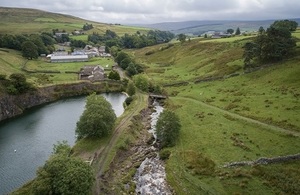Peatland work kick-starts multi-million pound project
A programme of peatland restoration has kick-started a £2.1million natural flood management (NFM) project in the North East.

The Kilhope Burn in Weardale
Weardale residents are reaping the benefits of a project which has kick-started a £2.1million natural flood management (NFM) project.
A programme of peatland restoration over last winter on a Weardale hillside will help reduce flooding further down the dale, as well as encouraging carbon capture and improving the land for nature.
And a film of the work has launched a new series of Environment Agency Youtube videos which will capture the pioneering Weardale project throughout.
There is also an introductory video about the whole project and what it aims to achieve.
Introduction to Weardale Natural Flood Management project
Extensive areas restored
The North Pennines AONB Partnership worked with East Allenheads Estate to restore extensive areas of bare peat on Wolfcleugh Common, above Rookhope.
It’s the first step for the Weardale Natural Flood Management pilot project which will see the Environment Agency and its partners investigate the potential for a much bigger initiative.
The ambition is to deliver natural features across 100km2 area to reduce the risk of flooding to 141 properties and create a haven for wildlife to thrive.
The project team is currently carrying out an assessment of NFM techniques that might help reduce flood risk in Weardale and takes in towns and villages including Stanhope, Westgate, Eastgate and Wolsingham.
The Environment Agency is working on the project with Natural England, Forestry Commission, Durham County Council, the North Pennines AONB Partnership and the Wear Catchment Partnership, established under Defra’s Catchment Based Approach.
The project team, supported by Wear Rivers Trust, is now working with local farmers and landowners to discuss voluntary involvement in the scheme for future features to be delivered on site at the end of this year.
The peatland restoration work at Rookhope includes installing coir rolls and stone dams to slow down the flow of surface water over bare peat. Steep sided erosion gullies have been reshaped to encourage revegetation, and heather and mosses have been harvested and spread over the bare peat. This helps protect it from further damage from wind, rain, frost and ice and also creates an ideal environment for seeds to germinate.
A series of videos of the Weardale work will be uploaded to Youtube so the community can understand the project and stay updated with progress.
Fantastic to see work completed
Alistair Lockett, Field Officer at the North Pennines AONB Partnership, said:
We have been working with Natural England and East Allenheads Estate for the past three years and it is fantastic to see the work completed. It will make a big difference to the valley, by improving carbon storage and mitigating flooding downstream. We’re also pleased that we have been able to support local contractors within the North Pennines.
Kirsty Hardy, the Environment Agency’s Project Manager for Weardale NFM scheme, added:
The AONB Partnership’s peatland restoration work kick starts what is a pioneering project to explore and deliver natural flood management features to reduce flood risk in Weardale, as well as enrich the landscape and habitat of what is a beautiful area of countryside.
Together with our partners we hosted a series of events in the Spring for the community to come along and find out more about the project. We’re now speaking with local farmers and landowners to identify any suitable locations for potential delivery of natural flood management features early next year.
This is a really exciting opportunity to increase our understanding of the impact natural flood management can have on reducing the risk of flooding. A series of videos about the project from start to finish will help people understand the process and stay up to date with progress.
In March 2017 the Environment Agency announced £15million of funding had been made available for NFM schemes nationally. Initial work to engage with farmers and communities and model the flood risk benefits that can be achieved will be complete by the end of the year. If this is successful then the project will deliver a programme of work from early 2019 for a two-year period.